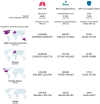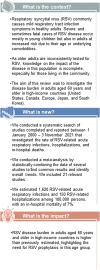Respiratory syncytial virus disease burden in adults aged 60 years and older in high-income countries: A systematic literature review and meta-analysis
- PMID: 36369772
- PMCID: PMC9835463
- DOI: 10.1111/irv.13031
Respiratory syncytial virus disease burden in adults aged 60 years and older in high-income countries: A systematic literature review and meta-analysis
Abstract
Background: Respiratory syncytial virus (RSV)-associated acute respiratory infection (ARI) is an underrecognized cause of illness in older adults. We conducted a systematic literature review and meta-analysis to estimate the RSV disease burden in adults ≥60 years in high-income countries.
Methods: Data on RSV-ARI and hospitalization attack rates and in-hospital case fatality rates (hCFR) in adults ≥60 years from the United States, Canada, European countries, Japan, and South Korea were collected based on a systematic literature search (January 1, 2000-November 3, 2021) or via other methods (citation search, unpublished studies cited by a previous meta-analysis, gray literature, and an RSV-specific abstract booklet). A random effects meta-analysis was performed on estimates from the included studies.
Results: Twenty-one studies were included in the meta-analysis. The pooled estimates were 1.62% (95% confidence interval [CI]: 0.84-3.08) for RSV-ARI attack rate, 0.15% (95% CI: 0.09-0.22) for hospitalization attack rate, and 7.13% (95% CI: 5.40-9.36) for hCFR. In 2019, this would translate into approximately 5.2 million cases, 470,000 hospitalizations, and 33,000 in-hospital deaths in ≥60-year-old adults in high-income countries.
Conclusions: RSV disease burden in adults aged ≥60 years in high-income countries is higher than previously estimated, highlighting the need for RSV prophylaxis in this age group.
Keywords: acute respiratory infection; disease burden; high-income countries; meta-analysis; older adults; respiratory syncytial virus.
© 2022 GlaxoSmithKline Biologicals SA and The Authors. Influenza and Other Respiratory Viruses published by John Wiley & Sons Ltd.
Conflict of interest statement
M Savic, Y Penders and JY Pirçon are employees of the GSK group of companies. M Savic and JY Pirçon hold shares in the GSK group of companies as part of their employee remuneration. A Branche was a paid consultant for the GSK group of companies during the conduct of the work reported in the manuscript and has received grants from Merck, Janssen, Cyanvac and Pfizer outside the submitted work. All authors declare no other financial or non‐financial relationships and activities.
Figures






References
-
- Devadiga R, Eckermann T, Helman LL, et al. Respiratory syncytial virus (RSV)‐associated burden of disease in older adults in Europe and the United States. Abstract E&E‐23. Presented at the 6th ReSViNET Conference 2021 [online virtual]; https://www.resvinet.org/uploads/2/2/2/7/22271200/abstract_booklet_rsvvw.... Accessed 27 February 2022.
Publication types
MeSH terms
LinkOut - more resources
Full Text Sources
Medical

